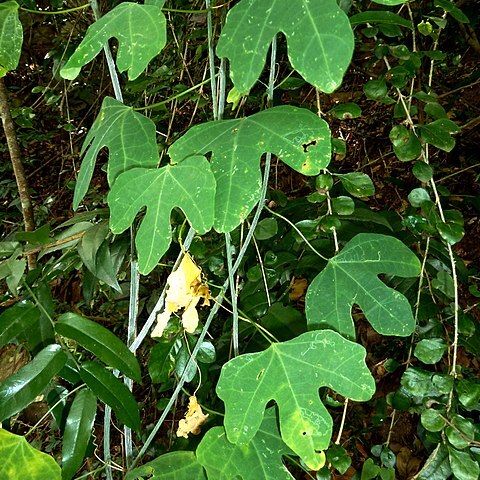Subligneous climber up to 30 m, up to 10 cm thick at base; twigs green or grey-green, often pruinose. Leaves rarely punctate, entire to deeply 3(-5)-lobed, orbicular to ovate or rhomboid, or ±3(-5)-angular in outline, base cordate to truncate, apex obtuse or retuse, rarely subacute, 2.5-11 x 2.5-11 cm, 3-plinerved and with 1 pair of straight nerves from the midrib ending in marginal glands; reticulation rather fine, distinct; margin entire; lobes obtuse, up to 4 cm; petiole 1.5-11 cm. Gland at blade-base single, on a median subcircular to spathulate appendage 1-3 mm; blade-glands 0-4, often 2 glands rather approximate to the axils of or contiguous with the upper side nerves; marginal glands minute, 3-7 on either side of the blade. Stipules broadly rounded to triangular, finely lacerate, 0.5(-1) mm. Inflorescences peduncled for (0.5-)1-12(-16) cm, up to 35-flowered in 5, 2-6-flowered in 9; tendrils 0 or 1.4 cm, sterile tendrils simple or 3-fid, 5-20 cm. Male flowers ± campanulate, including the 2-6 mm long stipe 11-17 mm; hypanthium cup-shaped, 1-2(-2.5) X 2-4 mm; calyx-tube 0; sepals lanceolate, subobtuse, (7-)8-10 x 3 mm, margin up to 0.2 mm laciniate, punctate; petals (ob)lanceolate, obtuse, (6-)8-11 mm, 3-nerved, finely laciniate-serrulate, remotely punctate; filaments (1-)2-3.5 mm, connate for (0-)0.5-1.5(-2) mm, inserted at the base of the hypanthium; anthers 3-6 mm, obtuse, up to 0.1 mm apiculate; septa 0-0.2 mm high; corona 0; disc-glands 0. Female flowers ± campanulate, including the c. 0.5 mm long stipe 5.5-8 mm; hypanthium flattish, c. 0.5 x 2.5(-3) mm; calyx-tube 0; sepals oblong, c. 4-6.5 mm, entire, punctate; petals lanceolate-linear, 2-4.5 mm, 1-3-nerved, sub-entire, sparingly punctate or not; staminodes c. 0.5 mm; septa 0; corona 0; disc-glands 0; gynophore c. 0.5 mm; ovary ovoid, 3-4.5 mm; style 0-0.5 mm; stigmas (sub)sessile, subreniform, laciniate-papillate, each c. 1-1.5 mm diam. Fruit 1-4 per inflorescence, ovoid to ellipsoid, sometimes ±3(-6)-angular, excluding the c. 1 mm long gynophore 2.5-4(-4.5) X 1.7-3 cm; pericarp woody-coriaceous, c. 0.2 mm thick, smooth or finely pitted or granulate; seeds 30-50 per capsule, subovate, 3.5-5.5 mm.
More
Subligneous climber, 0.5-30.0 m high. Leaves entire to 3(5)-lobed, ± orbicular; gland at blade-base solitary. Inflorescences: peduncles ending in tendrils. Flowers solitary or in cymes; corona absent. Male flowers more numerous; hypanthium cup-shaped, with stamens inserted at base; anthers up to 6 mm long, apiculate. Female flowers: receptacle funnel-shaped; sepals free; petals 5; disc glands absent; staminodes present; ovary ovoid, several ovules on 3(-5) parietal placentas; style short; stigmas (sub)sessile. Flowering time Dec., Jan. Fruit: each inflorescence with 1-4 stipitate, ± ovoid, 3-5-valved capsules; pericarp woody-coriaceous. Seeds 30-50 per capsule, subovate.
A climber. It is a succulent plant with a swollen base. It is a creeper with tendrils. The stems are grey. The leaf stalks are slender and 3 cm long. There is a small gland at the top. The leaf blades are 4 cm long. They have 3 broad blunt lobes. The edges are slightly wavy. The flowering shoots are in the axils of the leaves. These stalks are slender. The flowers are greenish-yellow. The fruit are oval and 2.5 cm long. The seeds are white with a netted surface.

